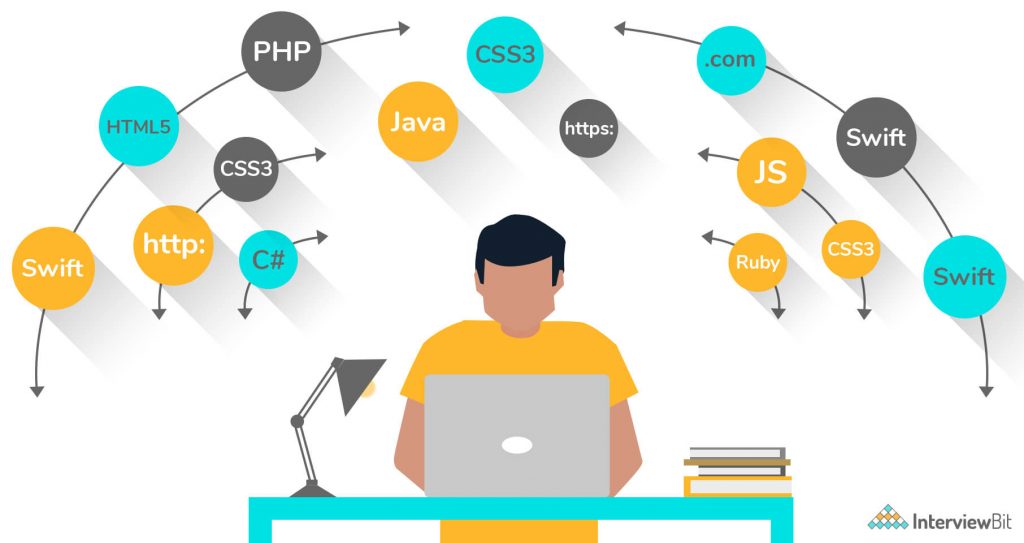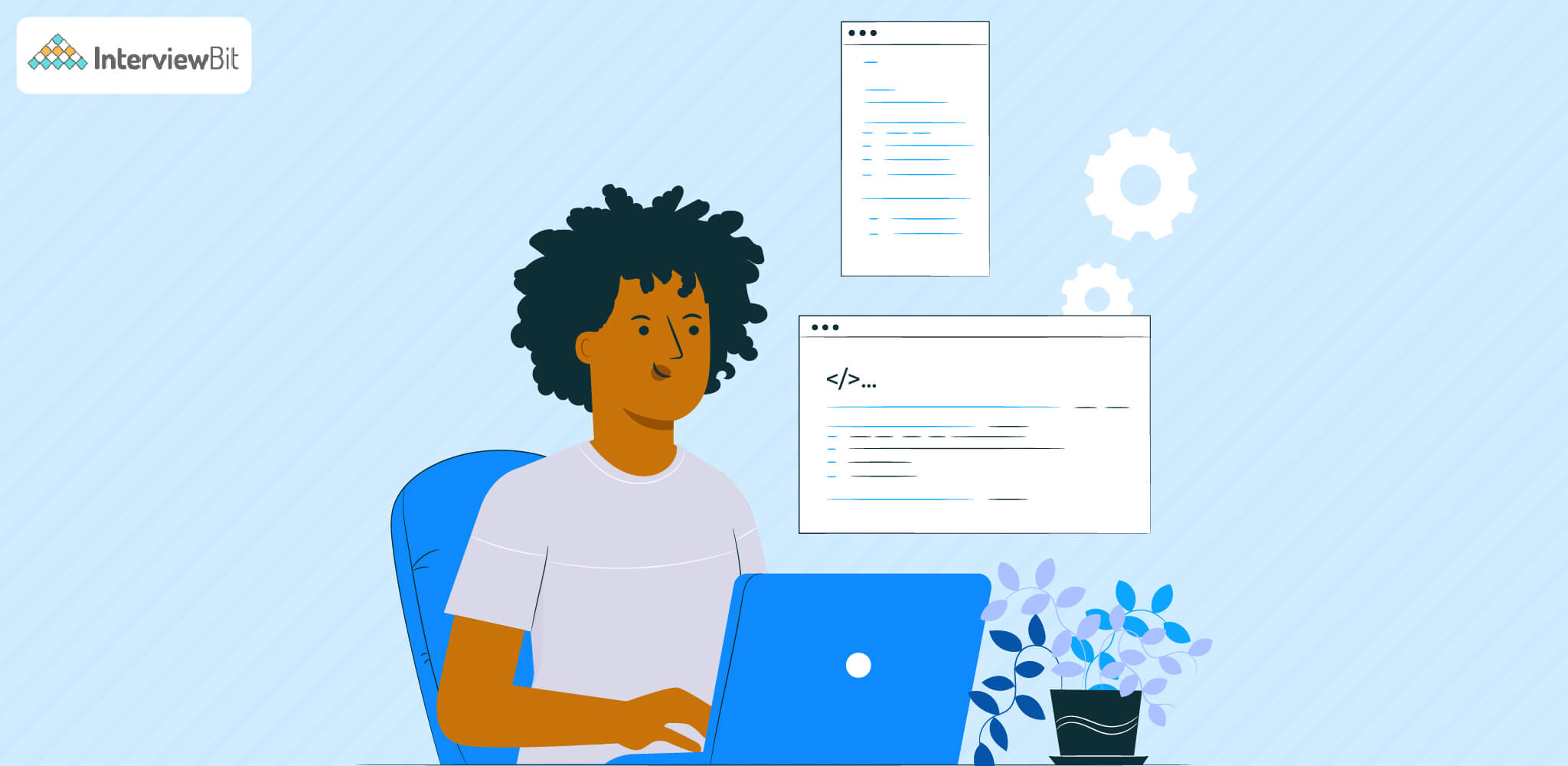- Who is a front-end developer?
- Front end vs Backend
- Top Front-End Developer Skills: Technical
- 1. HTML & CSS
- 2. Javascript
- 3. TypeScript
- 4. Frameworks and Libraries
- 5. CSS Preprocessors
- 6. Responsive Design
- 7. Cross-Browser Compatibility
- 8. Version Control
- 9. Testing and Debugging
- 10. Command Line
- 11. Web Performance
- Soft skills/ Non-technical Skills
- Conclusion
- Frequently Asked Questions
- 1. What does front-end development include?
- 2. What is better: Front-end or Back-end?
- 3. Is Front-End development stressful?
- 4. Which language is the best for front-end development?
- 5. Is front-end development a good career to opt for?
- 6. Is Python front end?
- 7. Is C++ useful for Front-end or Back-end?
- Additional Resources
Who is a front-end developer?
You might have been awestruck quite a few times while scrolling beautiful websites with complicated yet smooth features.
All of those visible site features are created using front-end development (also known as “front-end web development”), and the people who create them are known as front-end developers.
While web design is concerned with how a website appears, front-end development is concerned with how that design is deployed on the web.
Confused about your next job?
Front end vs Backend
A front-end developer is someone who uses coding languages like HTML, CSS, and JavaScript to construct web designs. Front-end developers are frequently referred to as “client-side developers” to separate themselves from back-end developers, who program what happens behind the scenes (like databases).
Backend developers must be fluent in programming languages that are used to render an application or website on the server side. Python, Ruby, Node.js, and Java are some of the most popular backend programming languages.
On the other side, frontend developers primarily use HTML, CSS, and JavaScript. Many front-end devs, on the other hand, are honing their JavaScript skills and using frameworks like Angular, Vue.js, or React.
Because front-end developers concentrate on the aesthetic user interface of applications and websites, they must be able to use design tools such as Sketch, Sigma, and Photoshop in addition to programming capabilities.
And, they are also involved in building systems, developing software architecture, and translating business logic into solutions, backend developers require critical thinking abilities. They must also look after issues such as the database to guarantee that user data is kept safe.
Top Front-End Developer Skills: Technical

Front-end developers require a combination of technical and soft abilities. If you’re pursuing a career as a Front-End Developer, these are the talents you’ll need to develop. The technical skills a front-end developer must have includes the following –
1. HTML & CSS
The cornerstones of web development are CSS (Cascading Style Sheets) and HTML (HyperText Markup Language). You may create a website with only these tools.
CSS is used to style the visual layout of the webpage, while HTML provides structure. These languages, as well as all of the other technical skills described here, are a developer’s toolkit, allowing you to start from scratch (or remix an existing platform).
The standard markup language for constructing web pages is HyperText Markup Language (HTML). It is the most fundamental building block for creating web pages.
CSS (Cascading Style Sheets) is the language that is used to present the HTML document. HTML is used to lay the groundwork for your website.
CSS, on the other hand, is used to create the page’s layout, colour, fonts, and style. Both of these languages are required to work as front-end developers.
2. Javascript
While CSS and HTML can be used to create a basic website, JavaScript is required to make the website interactive. You’ll be well on your way to landing developer gigs if you know all three of these languages.
Consider some of the interactive sites you’ve visited to help you recall what JavaScript works. JavaScript is required to run online gaming, quizzes, and animations.
JavaScript ES6 adds new syntax and great functionality to your code, making it more contemporary and readable. It enables you to write less code while doing more.
Many new features in ES6 include arrow functions, template strings, class destruction, modules, and more.
3. TypeScript
TypeScript allows you to write JavaScript in the way you desire. TypeScript is a typed JavaScript superset that compiles plain JavaScript.
TypeScript is a pure object-oriented programming language with classes, interfaces, and statically typed code, similar to C# or Java. TypeScript is used in the popular JavaScript framework Angular 2.0.
Understanding TypeScript can assist programmers in writing object-oriented programs that are compiled into JavaScript on both the server and client sides.
4. Frameworks and Libraries
Libraries like jQuery are part of JavaScript. It’s a collection of plugins and extensions that make using JS on your website faster and easier.
jQuery reduces common operations that require numerous lines of JS code into a structure that can be executed with just one line of code.
A number of frameworks are included with CSS and JavaScript. These are essentially CSS or JavaScript tools that can help you with a variety of tasks.
The good news for front-end developers is that they don’t have to start from scratch with every feature. Logging in to a website or using the search box on a blog, for example, are common functionalities for which these frameworks have components.
Frameworks have their own set of advantages and disadvantages. As a result, it’s critical to understand which framework is ideal for the application you’re developing.
While some JavaScript frameworks are excellent for creating complicated user interfaces, others are far superior for displaying highly optimized, simple website content such as paragraphs of text and photos.
Another advantage of this method is that it allows you to combine many frameworks. Many front-end developers, for example, combine the Bootstrap UI framework, which helps developers create high-performance and fast applications, with a JavaScript framework like Angular, which helps developers offer highly-performance and fast applications. While Angular is in charge of the content, Bootstrap is in charge of the application’s appearance and feel.
Because you’ll be using CSS and JavaScript frequently in your projects, and many of them will start with similar elements, learning these Front end frameworks is essential for being a productive team member. However, it’s best to start with the fundamentals.
Read More – Framework Vs Library
5. CSS Preprocessors
While CSS expertise is required, the language might be difficult to grasp at times. When your project’s scope and codebase expand, you may find yourself wasting a lot of time writing repetitive code, fiddling with incorrect file structures, or trying to figure out what the CSS shortcut “cascade” means when you accidentally create a few class names with the same name.
CSS preprocessing comes into play here. It’s essentially another method of making your life easier. SASS, LESS, and Stylus are CSS preprocessors that allow developers to create code in the preprocessor’s language.
That way, you can accomplish everything that would have been far more difficult to accomplish with plain old CSS. To verify that the code works on your website, the preprocessor will transform it into CSS.
6. Responsive Design

The days of merely using one device to access a web application are long gone. Consumers increasingly use a variety of devices, many of which are mobile, such as smartphones and tablets.
When it comes to web development, front-end developers must be aware of this and understand the fundamentals of responsive design.
When creating a website, make sure that the pages adapt to the device that your visitors are using. Today, knowing the principles of responsive design and how to apply them in your code is critical.
Remember that while responsive design is built into CSS frameworks like Bootstrap, nothing prevents you from writing your own responsive CSS rules.
7. Cross-Browser Compatibility
You might not consider how a website operates across different browsers when it comes to online performance. While most browsers now are capable of maintaining uniformity while displaying a site’s content, you may still notice minor discrepancies.
As a result, cross-browser development remains one of the most crucial front-end skills to have. You may think of this concept as an artist being able to work across several canvases, similar to how responsive design works.
8. Version Control
Version control is the process of recording and controlling changes to your source code so that if something goes wrong, you don’t have to start again.
It’s a program that lets you track prior changes so you can go back to a previous version of your work and figure out what went wrong without having to start from scratch.
Git is one of the most widely used version control systems. If you want to work in web development, you’ll need to learn how to use it.
9. Testing and Debugging
To keep your project bug-free, testing is an essential component. As a result, a front-end developer must have the capacity to test and debug code.
For web development, there are a variety of testing approaches. Functional testing examines a specific piece of functionality on your site and validates that it performs as expected by the code.
Another technique is unit testing, which evaluates each individual line of code for correct operation.
There are frameworks to assist you with testing, which is an important aspect of the front-end development process. Programs like Mocha and Jasmine are designed to make your testing process go faster and easier.
Mocha is a feature-rich JavaScript test framework that runs in the browser and on Node.js, making asynchronous testing simple and enjoyable.
Mocha tests run in sequential order, allowing for flexible and precise reporting while mapping uncaught exceptions to the appropriate test cases.
Jasmine is a free JavaScript framework that can be used to test any JavaScript application. To ensure that each line of JavaScript statement is adequately unit tested, Jasmine utilizes the Behavior Driven Development (BDD) method.
Jasmine uses the BDD method to give a simple syntax for testing the smallest unit of an application rather than the full application.
10. Command Line
The graphical user interface (GUI) is an important aspect of web development and coding. However, for some applications, an all-purpose GUI will have its limitations.
To get what you need, you may need to open a terminal on your computer and key in written commands or command lines. Although the majority of your work will be done through a GUI, mastering the command line will add substantial gravitas to your front-end talents.
11. Web Performance
HTML, CSS, and JavaScript are the three basic tools used in front-end development. However, you’ll need other abilities to make them more efficient and operate in your favour.
As a result, the best front-end developers are also experts in automation and web performance.
It doesn’t matter if you built an incredible website if the user experience is poor. Consumers today are ruthless, and if a website takes more than a few seconds to load, they are likely to abandon it.
That’s why savvy front-end developers know how to boost site performance without sacrificing functionality by compressing pictures or deleting any extraneous characters from their code.
Image optimization, CSS and JS minification, and other web performance tasks may be automated with tools like Grunt and gulp. It contributes to the efficiency of your website.
Soft skills/ Non-technical Skills
Some of the soft skills/non-tech skills that an ideal front-end developer must have are as follows –

1. Creativity
As a web developer, you may not be performing the heavy lifting in terms of design, but you still play an important role in the production and implementation of a website.
Thus, the ability to think creatively is required in order to achieve the vision provided by UI/UX or Web Designers as there are usually several correct approaches to designing a functional and beautiful front end, and development becomes an art form.
2. Teamwork
Frontend developers must be able to work well with others. You will need to communicate well with the client and cooperate with the complete project team because teamwork is a part of a front-end developer’s everyday life – even if you wind up being a freelance software developer!
Front-end engineers must know how to help others, seek help when needed, streamline workflows, and deliver the finished product quickly.
3. Problem-Solving
As a web developer, you are frequently responsible for resolving technical issues. This implies that you should be a problem-solver who isn’t frightened of working under pressure.
With a little practice and self-awareness, most soft talents can be developed. If you believe you are weak in any of these areas, realize that it is never too late to improve.
Conclusion
The specific talents a front-end developer is expected to have are highly dependent on the project and its requirements. However, if you want to get a head start in front-end development, you’ll need the skills we outlined earlier. We wish you all the best!
Frequently Asked Questions
1. What does front-end development include?
Ans: Front-end development includes the practice of translating data to a graphical interface using HTML, CSS, and JavaScript so that people can view and interact with that data. The skills mentioned above are crucial to any front-end developer.
2. What is better: Front-end or Back-end?
Ans: Front-end development necessitates contact with users and logic, as well as knowledge of how content is presented on various platforms, browsers, and capabilities. Front-end development is essentially all about UI design and development, as well as User Experience (UX), by guaranteeing an intuitive, responsive interface that works across browsers and devices.
Back-end development, on the other hand, necessitates client engagement as well as knowledge of how to model business domains and relationships. Back-end developers work across several databases and integrations from various service providers, with a strong focus on data. You never have to care about how something looks in back-end development; you just have to think about how it works and whether the functionality and underlying design meet the requirements.
According to a recent survey conducted by Stack Overflow, back-end developers earn more money than front-end developers. Full-stack developer jobs can pay even more. Money, after all, isn’t everything.
3. Is Front-End development stressful?
Ans: It is undeniably stressful to work in the field of web development. Along with the usual stressors of deadlines, demanding clients, and sophisticated coding, web developers must also meet specific artistic standards, which will undoubtedly add to their stress, despite the fact that this is more frequently assigned to web designers.
4. Which language is the best for front-end development?
Ans: When it comes to front-end development, JavaScript comes in first by default. According to the StackOverflow poll (which included 64,000 developers), it is the most popular frontend and backend programming language, and it continues to outperform Java, Python, PHP, C#, and other languages.
Because, JavaScript is so widely used in front-end development, there are a plethora of tools and extensions available to aid developers in writing, compiling, and optimizing code. JavaScript works on all platforms, including web browsers, mobile devices, and desktop operating systems.
5. Is front-end development a good career to opt for?
Ans: Yes. Front-end development is here to stay, given the rising web industry and the fact that so much of our lives are now lived online, and it can easily be a rewarding career choice.
Front-end developers also have great earning potential, so if you choose to work in this field, you may make a lot of money. Of course, this figure varies greatly depending on your level of experience and area (like with any job).
Another incentive to seek front-end development employment is the flexibility and possibility for creative growth they provide, in addition to being in great demand and paying well.
Even before the COVID-19 outbreak, many IT companies offered remote working options. Even once the pandemic is over, chances are you’ll have some freedom and flexibility in where and how you work as a tech worker.
You’ll get to exercise your creative problem-solving talents as a web developer, which may be very satisfying for people who enjoy being pushed at work. As we previously stated, there is rarely a single correct answer to a web development challenge. To create and communicate, you can use your tools, best practices, and a metaphorical canvas.
Given all of these considerations, it’s easy to conclude that web development is a fantastic career choice for someone who wants to be a lifelong learner, has a flexible schedule, and wants to advance in a high-demand field.
6. Is Python front end?
Ans: Python can be used for both front-end and back-end programming. Python is a core programming language for back-end development due to its simple syntax and broad server-side use.
Python for front-end development isn’t unheard of; it’s just not widely used. Python is an open-source programming language that may be used with the Flask and Django web frameworks.
7. Is C++ useful for Front-end or Back-end?
Ans: C++ is a popular programming language for competitive programming nowadays. It’s also popular as a back-end programming language. C++ is only useful if you need speed and control over memory allocation in your program.







 Join WhatsApp Group
Join WhatsApp Group


